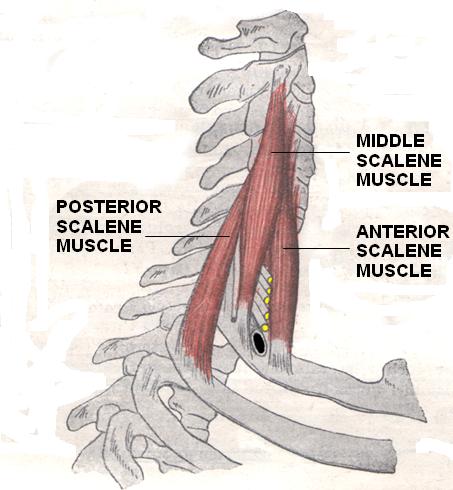Scalene
Original Editor - Your name will be added here if you created the original content for this page.
Lead Editors - Ilona Malkauskaite, Andeela Hafeez, Vanessa Rhule, Kim Jackson, Joao Costa, Naomi O'Reilly, Joshua Samuel, Venus Pagare, Lydia Xenou, George Prudden, WikiSysop, 127.0.0.1 and Oyemi Sillo
Description[edit | edit source]
Scalene are a group of three pairs of muscles in the lateral neck: scalenus anterior, scalenus medius and scalenus posterior. Sometimes a fourth muscle, the scalenus minimus is present behind the lower portion of the scalenus anterior. The brachial plexus and subclavian artery pass between the anterior and middle scalenes, while the subclavian vein and phrenic nerve pass anteriorly to the anterior scalene as the muscle crosses over the first rib.
Origin[edit | edit source]
- Scalenus Anterior: Anterior tubercles of the transverse processes of vertebrae C3-C6
- Scalenus Medius: Posterior tubercles of the transverse processes of vertebrae C2-C7
- Scalenus Posterior: Posterior tubercles of the transverse processes of vertebrae C5-C7
Insertion[edit | edit source]
- Scalenus Anterior: Scalene tubercle of the first rib
- Scalenus Medius: Upper surface of the first rib behind the subclavian artery
- Scalenus Posterior: Lateral surface of the second rib
Nerve Supply[edit | edit source]
- Scalenus Anterior: Brachial plexus, C5-C7
- Scalenus Medius: Brachial plexus, C3-C8
- Scalenus Posterior: Brachial plexus, C7-C8
Blood Supply[edit | edit source]
Ascending cervical artery, a branch of the Thyro-cervical trunk for all the 3 divisions of the Scalenus muscle.
Action[edit | edit source]
Flexes & rotates neck
Function[edit | edit source]
Elevates the first rib; flexes and laterally bends the neck
Pathologies:[edit | edit source]
Scalene myofascial pain syndrome is a regional pain syndrome wherein pain originates over the neck area and radiates down to the arm. This condition may present as primary or secondary to underlying cervical pathology.[1]Trigger point activity in the Scalene muscle group plays a significant role in many upper body pain complaints. A therapist must know this muscle group and its trigger points very well if they are to offer effective solutions to their client’s chest pain, upper back pain, shoulder pain, radiating arm pain or thoracic outlet syndrome, wrist pain, and hand pain complaints.these trigger points can cause chest pain and breathing difficulties, many clients become very concerned that they are experiencing cardiac symptoms[2].Clinical diagnoses to which this muscle symptoms may contribute are
Thoracic outlet syndrome
Subacromial tendinitis
Bicipital tendinitis
Lateral epicondylitis
Spasmodic torticollis (Wryneck syndrome)
Carpal tunnel syndrome
Costoclavicular syndrome (Cervical rib syndrome)
Activities that cause scalene pain and symptoms:[edit | edit source]
Whiplash injuries
Excessive coughing
Gasping for air (people who suffer with asthma, emphysema, or have bronchitis or pneumonia are especially susceptible to problematic scalene muscles
Pulling or lifting with arms level with the waist
Working for long-periods with head turned to one side (“word-processor headache”)
Sleeping on your stomach with your head turned to one side
Carrying a heavy backpack or purse
Wearing a tight collar or tie.[3]
Treatment:[edit | edit source]
The first thing you need to do to get rid of your scalene trigger points is to eliminate the underlying causes.[3]
It may be helpful to apply a hot pack or heating pad across the neck for 10 to 15 minutes before performing this stretch. Between stretches, use proper diaphragmatic breathing, taking deep, slow, breaths, to relax the neck.
Lie supine (face up) in your bed or on the floor
Lower and anchor the shoulder of the side to be stretched by placing that side's hand under your buttock
Bring the opposite hand over your head so that your fingers make contact with the top of the ear.
Gently pull the head and neck so that it tilts to the opposite side of the side you want to stretch, relaxing your neck muscles as you do so. Try to pull your ear down to your shoudler.
Now, you will rotate your head, and the degree of rotation will determine which scalene is targeted.
To target the posterior scalene, turn your face toward the arm that is pulling
To target the anterior scalene, turn your face away from the pulling arm.
To target the middle scalene, look straight up at the ceiling, or just slightly toward the pulling arm.
Concentrate your efforts on the muscle that feels the tightest when you rotate your head to target that muscle
Hold the stretch for around six to seven second.
Resources[edit | edit source]
Recent Related Research (from Pubmed)[edit | edit source]
Failed to load RSS feed from http://www.ncbi.nlm.nih.gov/entrez/eutils/erss.cgi?rss_guid=1J__86CjOXslvqEXZzRyJAnugEXZfRrdTS8FtD0dUDg82kVAiw|charset=UTF-8|short|max=10: Error parsing XML for RSS
References[edit | edit source]
References will automatically be added here, see adding references tutorial.
- ↑ Scalene Myofascial Pain Syndrome Mimicking Cervical Disc Prolapse: A Report of Two Cases Nizar Abd Jalil,1 Mohammad Saufi Awang,2 and Mahamarowi Omar1
- ↑ https://www.painscience.com/articles/spot-04-scalenes.php
- ↑ 3.0 3.1 http://www.gustrength.com/muscles:scalene-muscles-location-actions-trigger-points







